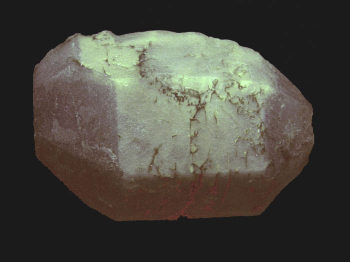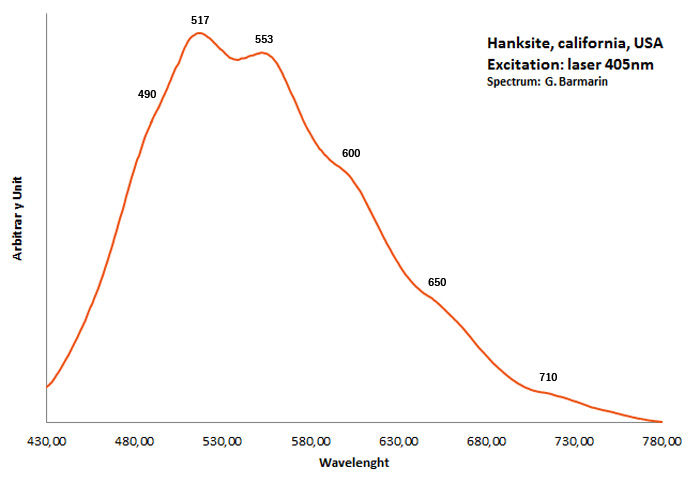Database of luminescent minerals
HANKSITE
Chemical formula: KNa22(SO4)9(CO3)2Cl
Family: Sulfates
Status: IMA-GP
Crystal system : Hexagonal
Display mineral: NON
Luminescence:
Longwave UV (365nm) colors: |
Yellowish White , | ||
Shortwave UV (254nm) colors: |
Yellowish White , | ||
Daylight picture
Shortwave (254nm) picture

HANKSITE;
UVSW
Photo and Copyright: James Hamblen
Site of the author
Used with permission of the author
Do you have a photo of this mineral you would like to see in the gallery? Contact us!
Phosphorescence (in the common sense of the term) observable with the naked eye:
Type d'UV |
Couleur |
Intensité |
Fréquence d'observation |
|---|---|---|---|
UV longs (365nm): | Yellowish White | UV courts (254 nm): | Yellowish White | Very Strong |
Activator(s) and spectrum:
No data
Peaks in the spectrum (nm):
490, 517, 553, 600, 650, 710nm

Hanksite, California, USA; Excitation: laser 405nm. Col. G. Barmarin; Spectre: G. Barmarin
Comments on spectrum and activators:
The luminescence of Hanksite was noticed by Kunz and Baskerville (1903) and has been studied by Melhase (1939).
Best localities for fluorescence (*):
- Searles Lake, San Bernardino Co., California, USA;
(*)The data are not exhaustive and are limited to a few remarkable localities for fluorescence
Bibliographic reference for luminescence:
- The Henkel Glossary of Fluorescent Minerals, Dr. Gerhard Henkel, Published by the FMS, 1989 ,
- Fluorescence: Gems and Minerals Under Ultraviolet Light, Manuel Robbins, 1994, Geoscience Press, ISBN 0-945005-13-X ,
- Handbook of Fluorescent Gems and Minerals, a practical guide for the gem and mineral collector, Jack de Ment, 1949 ,
Mineralogical reference on the Internet:
 http://www.mindat.org/show.php?name=Hanksite
http://www.mindat.org/show.php?name=Hanksite
 http://webmineral.com/data/Hanksite.shtml
http://webmineral.com/data/Hanksite.shtml
Internet Search:
 Image search on 'Google Images'
Image search on 'Google Images'
 Search for documents in all languages on Google
Search for documents in all languages on Google
A request providing no result means only that no such reference exists in the database, but it does not mean that what you are looking for does not exist, just not to our knowledge. If you think you have found an error or omission, please let us know via the contact page being sure to cite the source of information.

